2026届高考英语二轮复习:真题讲解课件(共24张PPT)
文档属性
| 名称 | 2026届高考英语二轮复习:真题讲解课件(共24张PPT) |  | |
| 格式 | pptx | ||
| 文件大小 | 2.1MB | ||
| 资源类型 | 教案 | ||
| 版本资源 | 通用版 | ||
| 科目 | 英语 | ||
| 更新时间 | 2025-07-16 17:23:57 | ||
图片预览

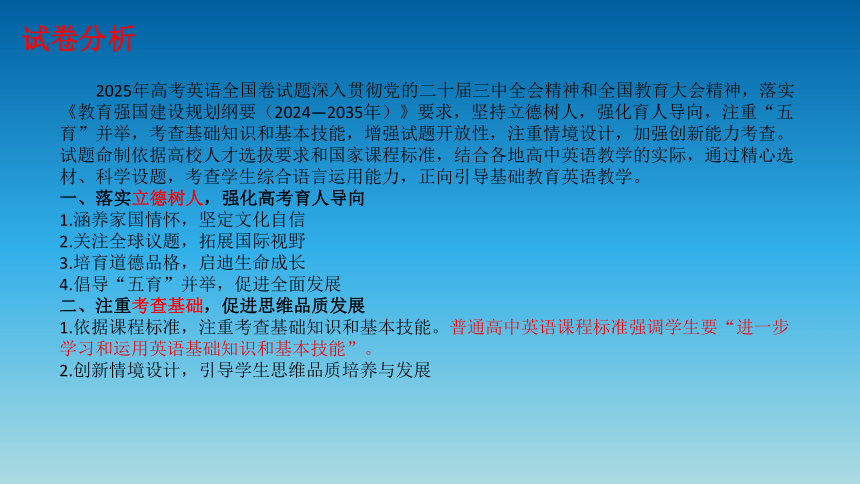
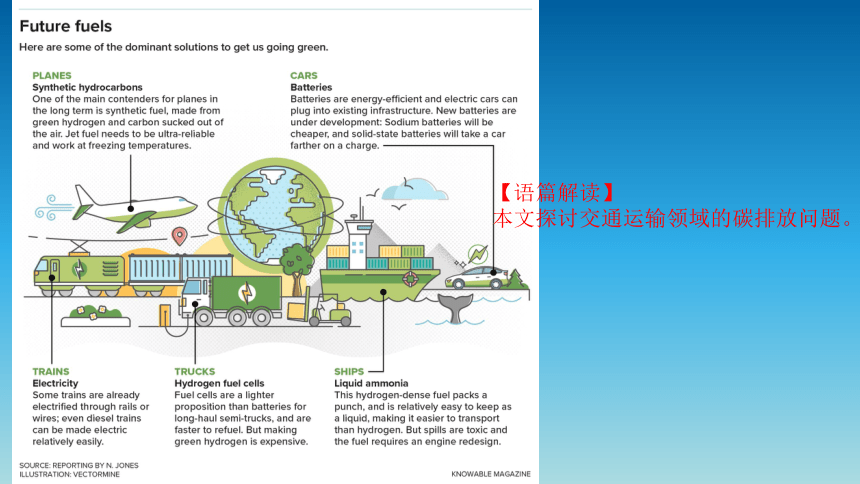
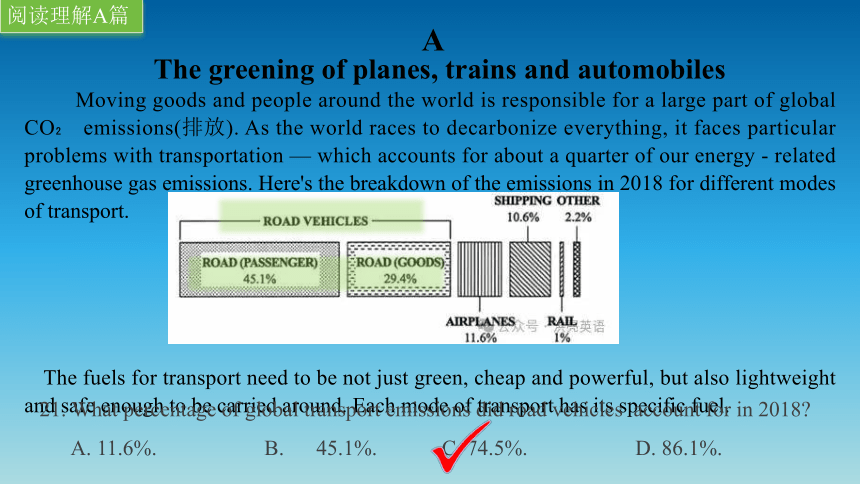
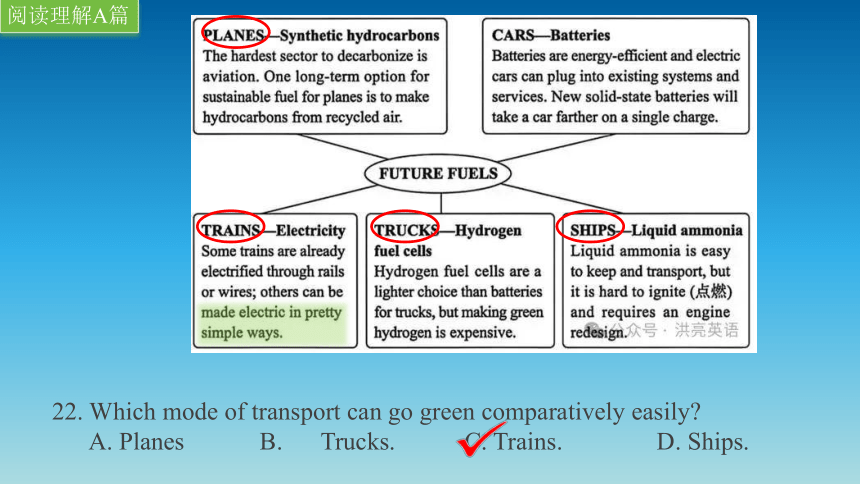
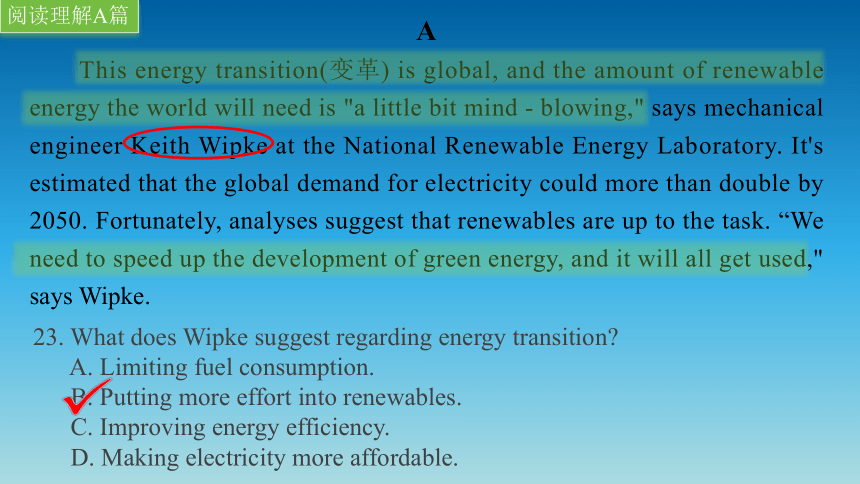
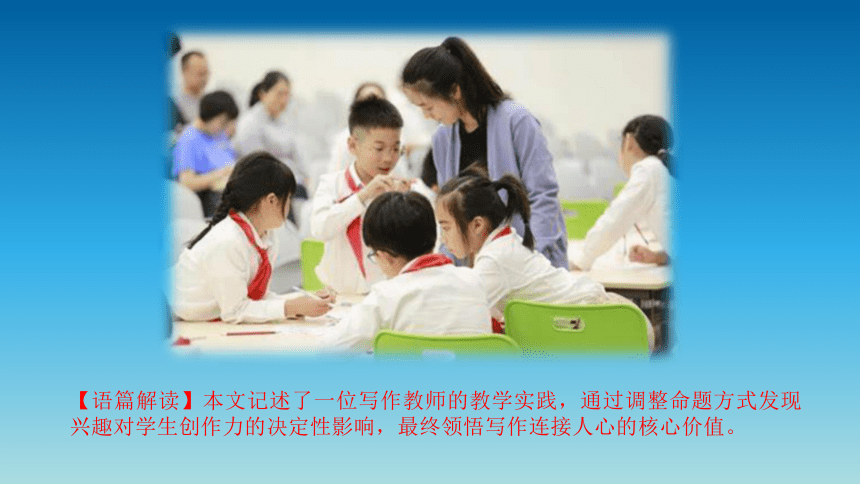
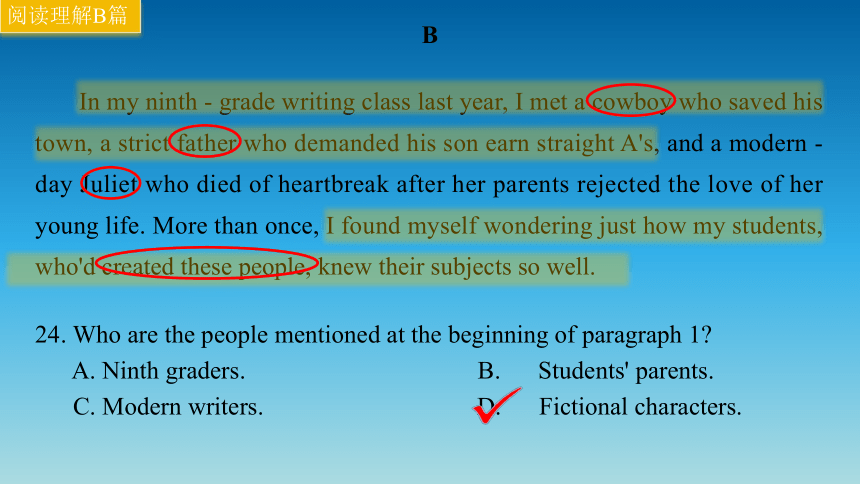
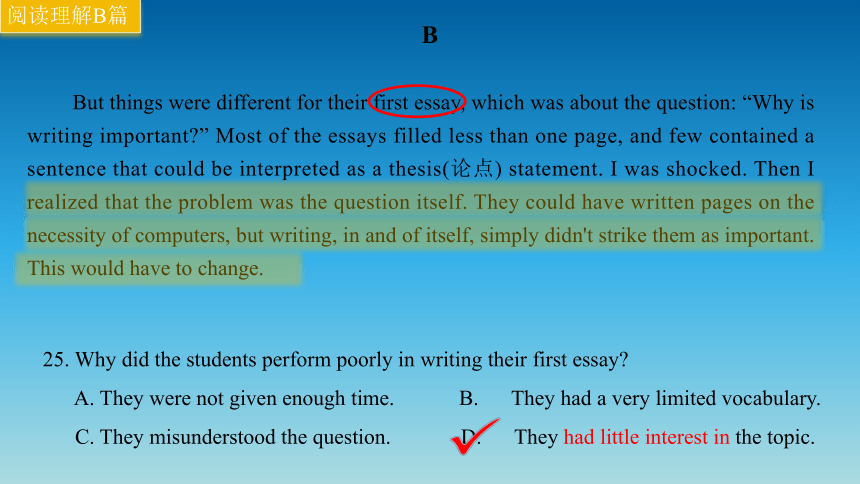
文档简介
(共24张PPT)
2025年高考英语
新课标Ⅰ卷
试卷详解
试卷分析
2025年高考英语全国卷试题深入贯彻党的二十届三中全会精神和全国教育大会精神,落实《教育强国建设规划纲要(2024—2035年)》要求,坚持立德树人,强化育人导向,注重“五育”并举,考查基础知识和基本技能,增强试题开放性,注重情境设计,加强创新能力考查。试题命制依据高校人才选拔要求和国家课程标准,结合各地高中英语教学的实际,通过精心选材、科学设题,考查学生综合语言运用能力,正向引导基础教育英语教学。
一、落实立德树人,强化高考育人导向
1.涵养家国情怀,坚定文化自信
2.关注全球议题,拓展国际视野
3.培育道德品格,启迪生命成长
4.倡导“五育”并举,促进全面发展
二、注重考查基础,促进思维品质发展
1.依据课程标准,注重考查基础知识和基本技能。普通高中英语课程标准强调学生要“进一步学习和运用英语基础知识和基本技能”。
2.创新情境设计,引导学生思维品质培养与发展
【语篇解读】
本文探讨交通运输领域的碳排放问题。
A
The greening of planes, trains and automobiles
Moving goods and people around the world is responsible for a large part of global CO emissions(排放). As the world races to decarbonize everything, it faces particular problems with transportation — which accounts for about a quarter of our energy - related greenhouse gas emissions. Here's the breakdown of the emissions in 2018 for different modes of transport.
The fuels for transport need to be not just green, cheap and powerful, but also lightweight and safe enough to be carried around. Each mode of transport has its specific fuel.
21. What percentage of global transport emissions did road vehicles account for in 2018
A. 11.6%. B. 45.1%. C. 74.5%. D. 86.1%.
阅读理解A篇
22. Which mode of transport can go green comparatively easily
A. Planes B. Trucks. C. Trains. D. Ships.
阅读理解A篇
A
This energy transition(变革) is global, and the amount of renewable energy the world will need is "a little bit mind - blowing," says mechanical engineer Keith Wipke at the National Renewable Energy Laboratory. It's estimated that the global demand for electricity could more than double by 2050. Fortunately, analyses suggest that renewables are up to the task. “We need to speed up the development of green energy, and it will all get used," says Wipke.
23. What does Wipke suggest regarding energy transition
A. Limiting fuel consumption.
B. Putting more effort into renewables.
C. Improving energy efficiency.
D. Making electricity more affordable.
阅读理解A篇
【语篇解读】本文记述了一位写作教师的教学实践,通过调整命题方式发现兴趣对学生创作力的决定性影响,最终领悟写作连接人心的核心价值。
24. Who are the people mentioned at the beginning of paragraph 1
A. Ninth graders. B. Students' parents.
C. Modern writers. D. Fictional characters.
B
In my ninth - grade writing class last year, I met a cowboy who saved his town, a strict father who demanded his son earn straight A's, and a modern - day Juliet who died of heartbreak after her parents rejected the love of her young life. More than once, I found myself wondering just how my students, who'd created these people, knew their subjects so well.
阅读理解B篇
25. Why did the students perform poorly in writing their first essay
A. They were not given enough time. B. They had a very limited vocabulary.
C. They misunderstood the question. D. They had little interest in the topic.
B
But things were different for their first essay, which was about the question: “Why is writing important ” Most of the essays filled less than one page, and few contained a sentence that could be interpreted as a thesis(论点) statement. I was shocked. Then I realized that the problem was the question itself. They could have written pages on the necessity of computers, but writing, in and of itself, simply didn't strike them as important. This would have to change.
阅读理解B篇
26. What does the underlined word “staggering” in paragraph 3 mean
A. Mixed. B. Amazing C. Similar. D. Disturbing.
B
As a new unit started, I asked everyone to write a persuasive piece on a health - related topic of their choice. This time they found the exercise much more interesting. For the next two assignments, a personal - narrative unit followed by a creative - writing workshop, I only required that the piece meet the specifications of its genre(体裁) and that it contain a thesis. The results were staggering. The students took on diverse topics and turned in stories, 10 to 20 pages each, with characters that broadened my view and touched my heart.
阅读理解B篇
27. What does the author's experience show
A. Teaching is learning. B. Still waters run deep.
C. Knowledge is power. D. Practice makes perfect.
B
阅读理解B篇
教学相长
I walked into class believing that writing is important as a means of communication. However, my students demonstrated something more important to me. When the final bell rang in June, I walked away with a yearbook full of messages about writing's most powerful significance — the ability to connect people, to put us in another's skin, to teach us what it means to be human.
熟能生巧
静水流深(大智若愚)
【语篇解读】本文批判汽车主导的街道规划导致儿童步行减少的现象,回溯历史抗争的有限成果,呼吁重新思考街道的社区价值。
28. What phenomenon does the author point out in paragraph 1
A. Cars often get stuck on the road. B. Traffic accidents occur frequently.
C. People walk less and drive more. D. Pedestrians fail to follow the rules.
While safety improvements might have been made to our streets in recent years, transport studies also show declines in pedestrian(行人) mobility, especially among young children. Many parents say there's too much traffic on the roads for their children to walk safely to school, so they pack them into the car instead.
C
阅读理解C篇
29. What were the Canadian journalist and other campaigners trying to do
A. Keep their cities livable. B. Promote cultural diversity.
C. Help the needy families. D. Make expressways accessible.
Dutch authors Thalia Verkade and Marco te Br mmelstroet are bothered by facts like these. In their new book Movement: How to Take Back Our Streets and Transform Our Lives, they call for a rethink of our streets and the role they play in our lives.
Life on city streets started to change decades ago. Whole neighbourhoods were destroyed to make way for new road networks and kids had to play elsewhere. Some communities fought back. Most famously, a Canadian journalist who had moved her family to Manhattan in the early 1950s led a campaign to stop the destruction of her local park. Describing her alarm at its proposed replacement with an expressway, Jane Jacobs called on her mayor(市长) to champion “New York as a decent place to live, and not just rush through.” Similar campaigns occurred in Australia in the late 1960s and 1970s as well.
阅读理解C篇
30. What can be inferred about the campaigns in Australia in the late 1960s and 1970s
A. They boosted the sales of cars.
B. They turned out largely ineffective.
C. They won government support.
D. They advocated building new parks.
阅读理解C篇
Although these campaigns were widespread, the reality is that the majority of the western cities were completely redesigned around the needs of the motor car. The number of cars on roads has been increasing rapidly. In Australia we now have over twenty million cars for just over twenty - six million people, among the highest rate of car ownership in the world. We invest a lot in roads that help us rush through, but we fail to account for the true costs. Do we really recognise what it costs us as a society when children can't move safely around our communities The authors of Movement have it right: it's time to think differently about that street outside your front door.
31. What can be a suitable title for the text
A. Why the Rush
B. What's Next
C. Where to Stay
D. Who to Blame
阅读理解C篇
解析:标题归纳题。 全文围绕汽车文化导致的"匆忙通行"(rush through)展开批判,末段直指问题核心"Do we recognise what it costs... "(我们是否意识到代价?),A项"Why the Rush "(为何匆忙?)以设问形式点明主旨,故选A项。
【语篇解读】本文描述作者在搬家时发帖赠送自己不用物品的经历及感悟。
41. A. painting over B. looking around C. emptying out D. pulling down
42. A. hotel B. office C. cottage D. Apartment
43. A. store B. display C. sell D. Repair
44. A. covered B. decorated C. stuffed D. equipped
完型填空
One August afternoon, I sat in my kitchen staring at a glass vase that hadn't seen daylight since my wedding.
My husband and I had just sold our house and we were busy 41. ____ the beloved home our family had spent 23 years filling up. We had decided on key items for the 42. _____ we were moving to in town, donated what we could, and rented a place to 43. ____ our supposedly important objects. That left a house still 44. ____ with things that, while not particularly 45. ___, didn't belong in a landfill(垃圾填埋场).
45. A. conventional B. valuable C. complicated D. tolerable
46. A. fees B. photos C. receipts D. Models
47. A. move B. pay C. market D. Work
48. A. warning B. request C. description D. Reply
49. A. Confused B. Interested C. Disappointed D. Encouraged
50. A. visits B. reports C. advice D. Money
51. A. remove B. spare C. find D. Check
52. A. investigated B. recognized C. encountered D. recommended
完型填空
I took a picture of the vase and posted it online, for $10. A couple of messages came in, one wanting additional 46. ____, another asking for a price cut. As our 47. ____ day drew near, I settled on a new price($0) and reposted it. The 48. ____: "I hate this vase. Maybe you won't.” In an instant, a woman raced into my house and left happily with the vase. 49. __, I posted more. My daily posts and the 50. ____ I received became a precious ray of light in the chaos of my house. Each exchange provided a chance to 51. ____ the landfill and to please another person I might not otherwise have 52. ____
完型填空
I sit in my apartment today, loving each of the 53. ________ that share our small space. I take 54. ________ in knowing that, somewhere nearby, someone is 55. ________ something that couldn't come with us.
53. A. giveaways B. posts C. contributions D. belongings
54. A. joy B. part C. care D. time
55. A. anticipating B. appreciating C. delivering D. withdrawing
An exhibition at the Jiushi Art Museum in Shanghai is featuring artwork inspired by Go, or weiqi in Chinese, 56. ________ originated in China more than 4,000 years ago.
Go is one of 57. ________ earliest binary - based(基于二元的) games. The movements of the black and white pieces reflect the basic ideas of Eastern philosophy, according to Tu Ningning, who is in charge of the exhibition.
语法填空
which
the
“The exhibition brings together Go culture, cutting - edge technology and contemporary art," says Tu. “We hope 58. ________ (present) the rather abstract Go game and AI in a visual context, and initiate dialogues with minimalist art, conceptual art and expressionism.”
"In a Go game, each move should serve a long - term goal. You try to lead the opponent into your trap and force them to follow your ‘59. ________ (guide)’ till they lose," explains Wang Wei, a Go player among the visitors to the exhibition.
语法填空
to present
guidance
“The players' personalities 60. _______________ (reveal) during the game, and one's weaknesses are exposed to the opponent," she adds. “A decent winner always 61. ________ (try) to beat the opponent 62. ________ no more than one or two points as a gesture(姿态) of respect for the other side.“
Tu says that the balance between the black and white pieces, the beauty in the 63. ________ (strategy) placement of the pieces, 64. ________ the energy flow following each move inspired artists to create oil paintings, sculptures, 65. ________ (digital) generated pictures and silk - screen prints for the exhibition.
语法填空
are revealed
tried
by
strategic
and
digitally
2025年高考英语
新课标Ⅰ卷
试卷详解
试卷分析
2025年高考英语全国卷试题深入贯彻党的二十届三中全会精神和全国教育大会精神,落实《教育强国建设规划纲要(2024—2035年)》要求,坚持立德树人,强化育人导向,注重“五育”并举,考查基础知识和基本技能,增强试题开放性,注重情境设计,加强创新能力考查。试题命制依据高校人才选拔要求和国家课程标准,结合各地高中英语教学的实际,通过精心选材、科学设题,考查学生综合语言运用能力,正向引导基础教育英语教学。
一、落实立德树人,强化高考育人导向
1.涵养家国情怀,坚定文化自信
2.关注全球议题,拓展国际视野
3.培育道德品格,启迪生命成长
4.倡导“五育”并举,促进全面发展
二、注重考查基础,促进思维品质发展
1.依据课程标准,注重考查基础知识和基本技能。普通高中英语课程标准强调学生要“进一步学习和运用英语基础知识和基本技能”。
2.创新情境设计,引导学生思维品质培养与发展
【语篇解读】
本文探讨交通运输领域的碳排放问题。
A
The greening of planes, trains and automobiles
Moving goods and people around the world is responsible for a large part of global CO emissions(排放). As the world races to decarbonize everything, it faces particular problems with transportation — which accounts for about a quarter of our energy - related greenhouse gas emissions. Here's the breakdown of the emissions in 2018 for different modes of transport.
The fuels for transport need to be not just green, cheap and powerful, but also lightweight and safe enough to be carried around. Each mode of transport has its specific fuel.
21. What percentage of global transport emissions did road vehicles account for in 2018
A. 11.6%. B. 45.1%. C. 74.5%. D. 86.1%.
阅读理解A篇
22. Which mode of transport can go green comparatively easily
A. Planes B. Trucks. C. Trains. D. Ships.
阅读理解A篇
A
This energy transition(变革) is global, and the amount of renewable energy the world will need is "a little bit mind - blowing," says mechanical engineer Keith Wipke at the National Renewable Energy Laboratory. It's estimated that the global demand for electricity could more than double by 2050. Fortunately, analyses suggest that renewables are up to the task. “We need to speed up the development of green energy, and it will all get used," says Wipke.
23. What does Wipke suggest regarding energy transition
A. Limiting fuel consumption.
B. Putting more effort into renewables.
C. Improving energy efficiency.
D. Making electricity more affordable.
阅读理解A篇
【语篇解读】本文记述了一位写作教师的教学实践,通过调整命题方式发现兴趣对学生创作力的决定性影响,最终领悟写作连接人心的核心价值。
24. Who are the people mentioned at the beginning of paragraph 1
A. Ninth graders. B. Students' parents.
C. Modern writers. D. Fictional characters.
B
In my ninth - grade writing class last year, I met a cowboy who saved his town, a strict father who demanded his son earn straight A's, and a modern - day Juliet who died of heartbreak after her parents rejected the love of her young life. More than once, I found myself wondering just how my students, who'd created these people, knew their subjects so well.
阅读理解B篇
25. Why did the students perform poorly in writing their first essay
A. They were not given enough time. B. They had a very limited vocabulary.
C. They misunderstood the question. D. They had little interest in the topic.
B
But things were different for their first essay, which was about the question: “Why is writing important ” Most of the essays filled less than one page, and few contained a sentence that could be interpreted as a thesis(论点) statement. I was shocked. Then I realized that the problem was the question itself. They could have written pages on the necessity of computers, but writing, in and of itself, simply didn't strike them as important. This would have to change.
阅读理解B篇
26. What does the underlined word “staggering” in paragraph 3 mean
A. Mixed. B. Amazing C. Similar. D. Disturbing.
B
As a new unit started, I asked everyone to write a persuasive piece on a health - related topic of their choice. This time they found the exercise much more interesting. For the next two assignments, a personal - narrative unit followed by a creative - writing workshop, I only required that the piece meet the specifications of its genre(体裁) and that it contain a thesis. The results were staggering. The students took on diverse topics and turned in stories, 10 to 20 pages each, with characters that broadened my view and touched my heart.
阅读理解B篇
27. What does the author's experience show
A. Teaching is learning. B. Still waters run deep.
C. Knowledge is power. D. Practice makes perfect.
B
阅读理解B篇
教学相长
I walked into class believing that writing is important as a means of communication. However, my students demonstrated something more important to me. When the final bell rang in June, I walked away with a yearbook full of messages about writing's most powerful significance — the ability to connect people, to put us in another's skin, to teach us what it means to be human.
熟能生巧
静水流深(大智若愚)
【语篇解读】本文批判汽车主导的街道规划导致儿童步行减少的现象,回溯历史抗争的有限成果,呼吁重新思考街道的社区价值。
28. What phenomenon does the author point out in paragraph 1
A. Cars often get stuck on the road. B. Traffic accidents occur frequently.
C. People walk less and drive more. D. Pedestrians fail to follow the rules.
While safety improvements might have been made to our streets in recent years, transport studies also show declines in pedestrian(行人) mobility, especially among young children. Many parents say there's too much traffic on the roads for their children to walk safely to school, so they pack them into the car instead.
C
阅读理解C篇
29. What were the Canadian journalist and other campaigners trying to do
A. Keep their cities livable. B. Promote cultural diversity.
C. Help the needy families. D. Make expressways accessible.
Dutch authors Thalia Verkade and Marco te Br mmelstroet are bothered by facts like these. In their new book Movement: How to Take Back Our Streets and Transform Our Lives, they call for a rethink of our streets and the role they play in our lives.
Life on city streets started to change decades ago. Whole neighbourhoods were destroyed to make way for new road networks and kids had to play elsewhere. Some communities fought back. Most famously, a Canadian journalist who had moved her family to Manhattan in the early 1950s led a campaign to stop the destruction of her local park. Describing her alarm at its proposed replacement with an expressway, Jane Jacobs called on her mayor(市长) to champion “New York as a decent place to live, and not just rush through.” Similar campaigns occurred in Australia in the late 1960s and 1970s as well.
阅读理解C篇
30. What can be inferred about the campaigns in Australia in the late 1960s and 1970s
A. They boosted the sales of cars.
B. They turned out largely ineffective.
C. They won government support.
D. They advocated building new parks.
阅读理解C篇
Although these campaigns were widespread, the reality is that the majority of the western cities were completely redesigned around the needs of the motor car. The number of cars on roads has been increasing rapidly. In Australia we now have over twenty million cars for just over twenty - six million people, among the highest rate of car ownership in the world. We invest a lot in roads that help us rush through, but we fail to account for the true costs. Do we really recognise what it costs us as a society when children can't move safely around our communities The authors of Movement have it right: it's time to think differently about that street outside your front door.
31. What can be a suitable title for the text
A. Why the Rush
B. What's Next
C. Where to Stay
D. Who to Blame
阅读理解C篇
解析:标题归纳题。 全文围绕汽车文化导致的"匆忙通行"(rush through)展开批判,末段直指问题核心"Do we recognise what it costs... "(我们是否意识到代价?),A项"Why the Rush "(为何匆忙?)以设问形式点明主旨,故选A项。
【语篇解读】本文描述作者在搬家时发帖赠送自己不用物品的经历及感悟。
41. A. painting over B. looking around C. emptying out D. pulling down
42. A. hotel B. office C. cottage D. Apartment
43. A. store B. display C. sell D. Repair
44. A. covered B. decorated C. stuffed D. equipped
完型填空
One August afternoon, I sat in my kitchen staring at a glass vase that hadn't seen daylight since my wedding.
My husband and I had just sold our house and we were busy 41. ____ the beloved home our family had spent 23 years filling up. We had decided on key items for the 42. _____ we were moving to in town, donated what we could, and rented a place to 43. ____ our supposedly important objects. That left a house still 44. ____ with things that, while not particularly 45. ___, didn't belong in a landfill(垃圾填埋场).
45. A. conventional B. valuable C. complicated D. tolerable
46. A. fees B. photos C. receipts D. Models
47. A. move B. pay C. market D. Work
48. A. warning B. request C. description D. Reply
49. A. Confused B. Interested C. Disappointed D. Encouraged
50. A. visits B. reports C. advice D. Money
51. A. remove B. spare C. find D. Check
52. A. investigated B. recognized C. encountered D. recommended
完型填空
I took a picture of the vase and posted it online, for $10. A couple of messages came in, one wanting additional 46. ____, another asking for a price cut. As our 47. ____ day drew near, I settled on a new price($0) and reposted it. The 48. ____: "I hate this vase. Maybe you won't.” In an instant, a woman raced into my house and left happily with the vase. 49. __, I posted more. My daily posts and the 50. ____ I received became a precious ray of light in the chaos of my house. Each exchange provided a chance to 51. ____ the landfill and to please another person I might not otherwise have 52. ____
完型填空
I sit in my apartment today, loving each of the 53. ________ that share our small space. I take 54. ________ in knowing that, somewhere nearby, someone is 55. ________ something that couldn't come with us.
53. A. giveaways B. posts C. contributions D. belongings
54. A. joy B. part C. care D. time
55. A. anticipating B. appreciating C. delivering D. withdrawing
An exhibition at the Jiushi Art Museum in Shanghai is featuring artwork inspired by Go, or weiqi in Chinese, 56. ________ originated in China more than 4,000 years ago.
Go is one of 57. ________ earliest binary - based(基于二元的) games. The movements of the black and white pieces reflect the basic ideas of Eastern philosophy, according to Tu Ningning, who is in charge of the exhibition.
语法填空
which
the
“The exhibition brings together Go culture, cutting - edge technology and contemporary art," says Tu. “We hope 58. ________ (present) the rather abstract Go game and AI in a visual context, and initiate dialogues with minimalist art, conceptual art and expressionism.”
"In a Go game, each move should serve a long - term goal. You try to lead the opponent into your trap and force them to follow your ‘59. ________ (guide)’ till they lose," explains Wang Wei, a Go player among the visitors to the exhibition.
语法填空
to present
guidance
“The players' personalities 60. _______________ (reveal) during the game, and one's weaknesses are exposed to the opponent," she adds. “A decent winner always 61. ________ (try) to beat the opponent 62. ________ no more than one or two points as a gesture(姿态) of respect for the other side.“
Tu says that the balance between the black and white pieces, the beauty in the 63. ________ (strategy) placement of the pieces, 64. ________ the energy flow following each move inspired artists to create oil paintings, sculptures, 65. ________ (digital) generated pictures and silk - screen prints for the exhibition.
语法填空
are revealed
tried
by
strategic
and
digitally
